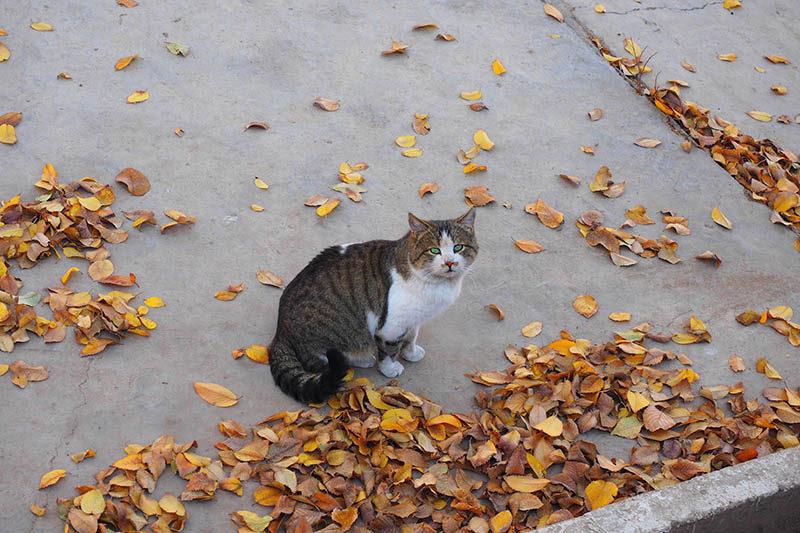Click to Skip Ahead
Deciding what to name your new cat or kitten can be overwhelming. One way to narrow it down is to consider names inspired by a specific theme, or in this case, a season! Whether your kitty’s “Coming Home Day” lands during autumn or you are a fan of all things pumpkin spice, here are 130 fall-inspired cat names to consider.
How to Name Your Cat
Even if you narrow your choices down to fall-inspired names, that still leaves plenty of options. You’ll need to dig deeper as you decide what to name your cat. Choose a name based on your cat’s physical appearance, such as their color or pattern.
Take some time to get to know their personality, and it could help you decide if a sweet or scary name fits better. Another option is to consider your personal favorites. Do you love a certain fall holiday, food, or drink? No matter what you decide, be consistent. Cats can learn their names, so don’t confuse them by changing your mind once you pick one.
Cat Names Inspired by Fall Food and Drink

In many parts of the world, fall signals the arrival of cooler weather along with a change in food and drink preferences. Fall holidays like Halloween and Thanksgiving are closely associated with food. Why not find culinary inspiration for your cat’s name?
- Pumpkin
- Cinnamon
- Nutmeg
- Spice
- Cider
- Butternut
- Clove
- Turkey
- Sage
- Soup
- Ginger
- Hazelnut
- Chestnut
- Sweet Potato
- Marshmallow
- Cocoa
- Chocolate
- Whiskey
- Apple
- Maple
- S’mores
- Graham
- Caramel
- Toffee
- Brandy
- Starbucks
- Candy
- Snickers
- Butterfinger
- Jellybean
- Candy Corn
- Saffron
- Russet
- Mash
- Bourbon
- Pepper

Fall Cat Names Inspired by Nature
For many people, the best part of fall is the beautiful display put on by nature. Fall foliage inspires many a leaf-watching trip, which might lead you to the perfect cat name.
- Scarlet
- Leaf
- Oak
- Branch
- Twig
- Autumn
- Acorn
- Birch
- Ash
- Pine
- Copper
- Forest
- Hunter
- Rain
- Windy
- Woody
- Amber
- Crimson
- Juniper
- Harvest
- Sparrow
- Ruby
- Willow
- Midnight
- Ember
- Cinder
- Twilight
- Raven
- Shadow
- Soot
- Crow
- Flame
- Cedar
- Archer
Fall Cat Names Inspired by Halloween

You don’t have to have a black cat to pick a name inspired by Halloween. This spooky holiday offers many options for naming your cat, from scary characters to sweet treats.
- Ghost
- Monster
- Zombie
- Vampire
- Dracula
- Frankenstein
- Edward
- Freddy
- Jason
- Bella
- Wizard
- Magic
- Spook
- Inky
- Lucifer
- Demon
- Devil
- Michael
- Hocus Pocus
- Thackery Binx
- Crookshanks
- Church
- Phantom
- Casper
- Igor
- Bones
- Gremlin
- Draco
- Grim
- Gargamel
- Trick
- Treat
- Fang
- Mummy
- Boo
- Sabrina
- Salem
Fall Cat Names Inspired by Clothing
It’s time to break out your fall wardrobe favorites as the weather turns colder. They don’t call it “sweater weather” for no reason. If your cat loves to snuggle and get cozy, why not name them after one of these fall clothing items?
- Sweaters
- Plaid
- Flannel
- Fleece
- Beanie
- Socks
- Boots
- Jeans
- Wooly
- Cashmere
- Tux
- Buttons
- Chukka
Fall Calendar-Inspired Cat Names

Whether we’re talking about the traditional or zodiac calendar, you can find a unique fall-inspired name for your cat on this list.
- October
- September
- Libra
- Scorpio
- Sagittarius
- Virgo
- Equinox
- Mars
- Mercury
- Pluto

Conclusion
Hopefully, these fall-inspired cat names have sparked your creativity as you get to know your new pet. Remember, before you bring home a cat that needs a name, make sure you’re prepared for the commitment it takes to care for them. Owning a cat isn’t just a seasonal trend but a lifetime responsibility.
Featured Image Credit: Shino, Unsplash










